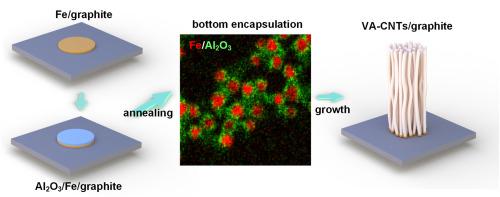无缺陷二维材料上三维异质结构垂直接枝碳纳米管的催化剂成核增强
IF 11.6
2区 材料科学
Q1 CHEMISTRY, PHYSICAL
引用次数: 0
摘要
合理设计的集成各向异性低维材料(如一维纳米管和二维晶体)的三维异质结构具有单个组分无法实现的协同特性。这种结构将一维材料的轴向各向异性与二维材料的面内特性相结合,在面外导电、三维热扩散等领域具有广阔的应用前景。在本研究中,通过优化的Al2O3/Fe/石墨催化体系,合成了由垂直排列的碳纳米管(VA-CNTs)和无缺陷石墨组成的三维化学键合异质结构,形成了不含中间介电层的3D VA-CNTs/石墨同素异质结构。实验证明,无定形Al2O3的存在有效地限制了Fe纳米颗粒的横向迁移,抑制了它们的成熟,从而降低了催化剂颗粒的尺寸分散,最终促进了VA-CNTs的有序生长。此外,这种约束机制也适用于其他二维材料,如h-BN,从而拓宽了其潜在的应用范围。这揭示了一种基于分层碳纳米管接枝的新型各向异性三维纳米结构的新方法,允许利用两种纳米材料的固有特性,在各个领域具有潜在的应用前景。本文章由计算机程序翻译,如有差异,请以英文原文为准。

Enhanced catalyst nucleation for vertically grafted CNTs in 3D heterostructures on defect-free 2D materials
A rationally designed three-dimensional (3D) heterostructure integrating anisotropic low-dimensional materials (such as one-dimensional nanotubes and two-dimensional crystals) exhibits synergistic properties unattainable in individual components. By combining the axial anisotropy of 1D materials with the in-plane characteristics of 2D materials, such architectures offer broad application prospects in areas such as out-of-plane electrical conduction and 3D thermal diffusion. In this study, a 3D chemically bonded heterostructure comprising vertically aligned carbon nanotubes (VA-CNTs) and defect-free graphite was synthesized via optimized Al2O3/Fe/graphite catalytic system, forming a 3D VA-CNTs/graphite allotropic heterostructure without an intermediate dielectric layer. Experiments have proved that the presence of amorphous Al2O3 effectively confines lateral migration of Fe nanoparticles and suppresses their ripening, thereby reducing the size dispersion of the catalyst particles, ultimately facilitating an ordered growth of VA-CNTs. Furthermore, this confinement mechanism shows its applicability to other 2D materials like h-BN, which broadens its potential applications. This reveals a new way of developing novel anisotropic 3D nanostructures based on hierarchical CNT grafting, allowing the utilization of the intrinsic properties of both nanomaterials, with potential applications in various fields.
求助全文
通过发布文献求助,成功后即可免费获取论文全文。
去求助
来源期刊

Carbon
工程技术-材料科学:综合
CiteScore
20.80
自引率
7.30%
发文量
0
审稿时长
23 days
期刊介绍:
The journal Carbon is an international multidisciplinary forum for communicating scientific advances in the field of carbon materials. It reports new findings related to the formation, structure, properties, behaviors, and technological applications of carbons. Carbons are a broad class of ordered or disordered solid phases composed primarily of elemental carbon, including but not limited to carbon black, carbon fibers and filaments, carbon nanotubes, diamond and diamond-like carbon, fullerenes, glassy carbon, graphite, graphene, graphene-oxide, porous carbons, pyrolytic carbon, and other sp2 and non-sp2 hybridized carbon systems. Carbon is the companion title to the open access journal Carbon Trends. Relevant application areas for carbon materials include biology and medicine, catalysis, electronic, optoelectronic, spintronic, high-frequency, and photonic devices, energy storage and conversion systems, environmental applications and water treatment, smart materials and systems, and structural and thermal applications.
 求助内容:
求助内容: 应助结果提醒方式:
应助结果提醒方式:


